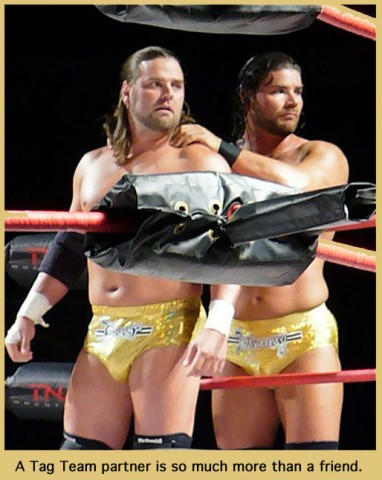 The term “Homosocial” was coined by feminist scholars to describe non-sexual relationships between people of the same sex. Yes, you have homosocial bonds in place with all your buddies — but don’t panic — it is not the same as being gay. A homosocial relationship is just a “Bromance”: a bond with no overt sexual activity between two friends of the same gender.
The term “Homosocial” was coined by feminist scholars to describe non-sexual relationships between people of the same sex. Yes, you have homosocial bonds in place with all your buddies — but don’t panic — it is not the same as being gay. A homosocial relationship is just a “Bromance”: a bond with no overt sexual activity between two friends of the same gender.
“Homosocial” is also used to describe same-sex groups living together with nobody of the opposite sex around, such as in fraternities, prisons, sports teams, etc.
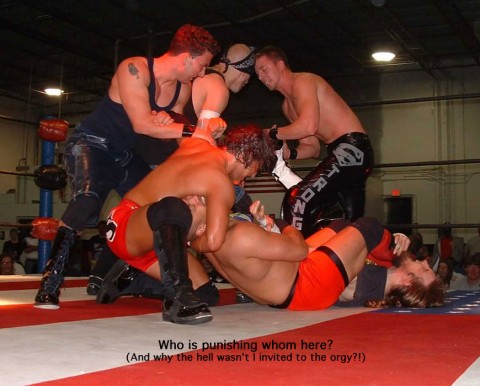 A pro wrestling federation is a homosocial society. Yes, there may be some Divas, girlfriends, or Valets on the periphery, who are involved somewhat in the plots, but they serve mostly as eye-candy and are used to avert any homo-erotic overtones.
A pro wrestling federation is a homosocial society. Yes, there may be some Divas, girlfriends, or Valets on the periphery, who are involved somewhat in the plots, but they serve mostly as eye-candy and are used to avert any homo-erotic overtones.
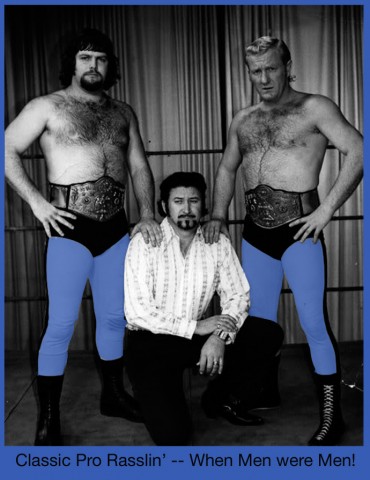 The female talent, you must admit, are essentially non-existent in the most important power struggles between the men, the winning of championships, the mission critical story lines. Most of the television time on a pro wrestling show is devoted to the men: their interactions, drama, and homosocial couplings.
The female talent, you must admit, are essentially non-existent in the most important power struggles between the men, the winning of championships, the mission critical story lines. Most of the television time on a pro wrestling show is devoted to the men: their interactions, drama, and homosocial couplings.
Our patriarchal society encourages men to form these very close bonds with one another, to engage in activities such as sports, hunting, or clubs that exclude women. Men gain power, esteem, and friendship by participating in this “male bonding.” Indeed, a boy will be mocked as a sissy if he plays with girls more than boys. Feminists believe this is how men maintain the power advantage — by excluding women and establishing their truly empowering and most meaningful relationships only with other men.
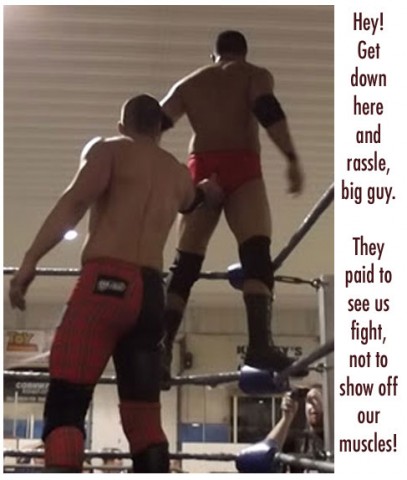 At the same time males are encouraged to bond, they are (ironically) warned from a young age to avoid potential sexual attraction and contact with men. Homosocial relationships are required, but homosexual relationships are strictly forbidden. This is known as the “double bind”. It strangles men socially and prevents them from forming healthy bonds with other males. A man lives in constant panic that one of his buds might cross the line and try something queer, or worse yet, that he himself may begin to feel desire or romantic love for one of his chums.
At the same time males are encouraged to bond, they are (ironically) warned from a young age to avoid potential sexual attraction and contact with men. Homosocial relationships are required, but homosexual relationships are strictly forbidden. This is known as the “double bind”. It strangles men socially and prevents them from forming healthy bonds with other males. A man lives in constant panic that one of his buds might cross the line and try something queer, or worse yet, that he himself may begin to feel desire or romantic love for one of his chums.
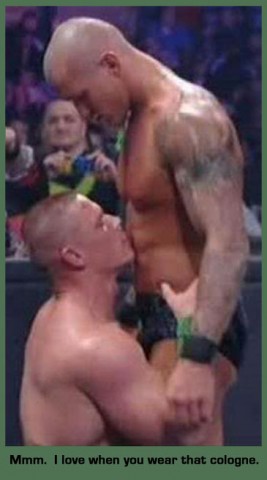 I believe pro wrestling is enjoyable for men to watch, that it remains popular among males, because it freely endorses and allows intense homosocial relationships (which all men crave) — while also resolving the double bind issue through violence. Wrestling portrays men in the most intimate possible contact, but they can never cross the line into that scary gay territory because the men are depicted as enemies.
I believe pro wrestling is enjoyable for men to watch, that it remains popular among males, because it freely endorses and allows intense homosocial relationships (which all men crave) — while also resolving the double bind issue through violence. Wrestling portrays men in the most intimate possible contact, but they can never cross the line into that scary gay territory because the men are depicted as enemies.
The wrestlers aren’t trying to HUG each other; we understand that they’re trying to HURT each other. How could a man want to become intimate with the foe he is apparently trying to injure and destroy?? Their hyper-masculine appearance, their athletic builds and big muscles, also avert any potential queerness, because haven’t we been taught that gays are sissified, effeminate, and swishy? How could these brawling He-Men possibly be closeted fags??
Pro wrestling is able to dance around in that gray area between homosocial and homosexual. The fans can safely enjoy images of men punishing, dominating, stripping, and embracing each other, while any gayness is averted by the situation. The wrestlers are trying to win the gold belt and punish the wrong-doers, not getting it on.
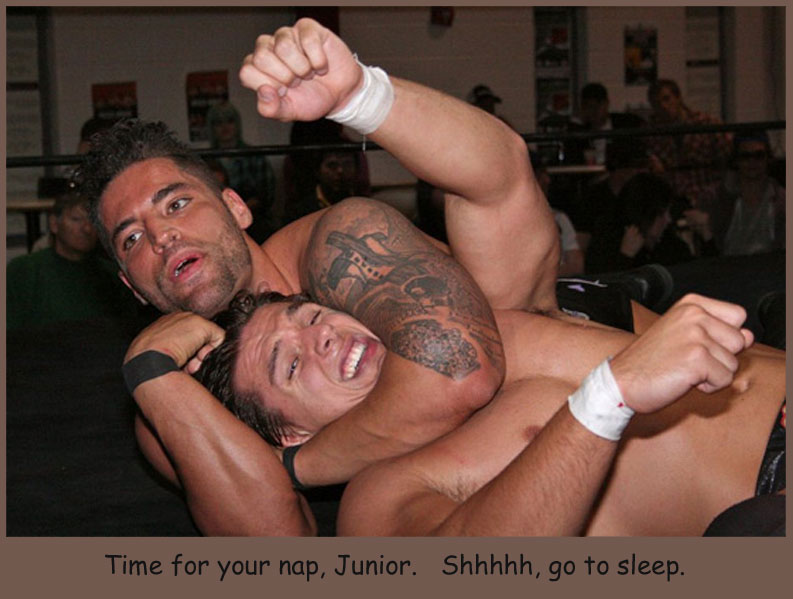
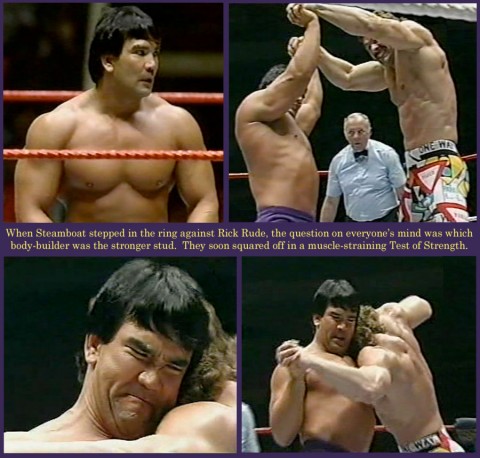 The fact that wrestlers fight is what identifies and defines them as men. They engage in violent battles, flex their muscles, and test their strength against one another — all behaviors associated with masculinity. Their actions proclaim loud and clear that these are heterosexual men in a homosocial context.
The fact that wrestlers fight is what identifies and defines them as men. They engage in violent battles, flex their muscles, and test their strength against one another — all behaviors associated with masculinity. Their actions proclaim loud and clear that these are heterosexual men in a homosocial context.
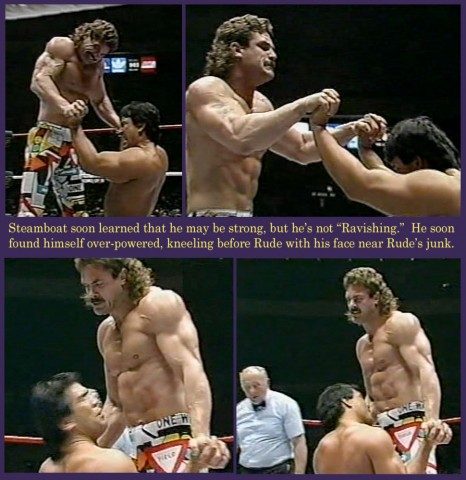 But theoretically, every relationship between men lands somewhere between a purely homosocial (non-sexual) friendship and a completely homosexual love affair. Whether our patriarchal power structure likes it or not, most homosocial male bonding experiences are rife with at least some erotic undertones, and pro wrestling is no exception.
But theoretically, every relationship between men lands somewhere between a purely homosocial (non-sexual) friendship and a completely homosexual love affair. Whether our patriarchal power structure likes it or not, most homosocial male bonding experiences are rife with at least some erotic undertones, and pro wrestling is no exception.

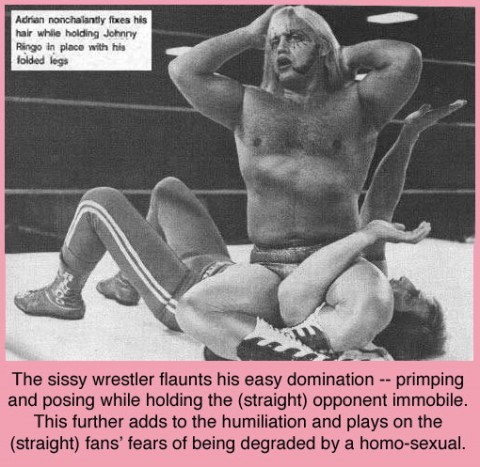
The second image, where’s that from?